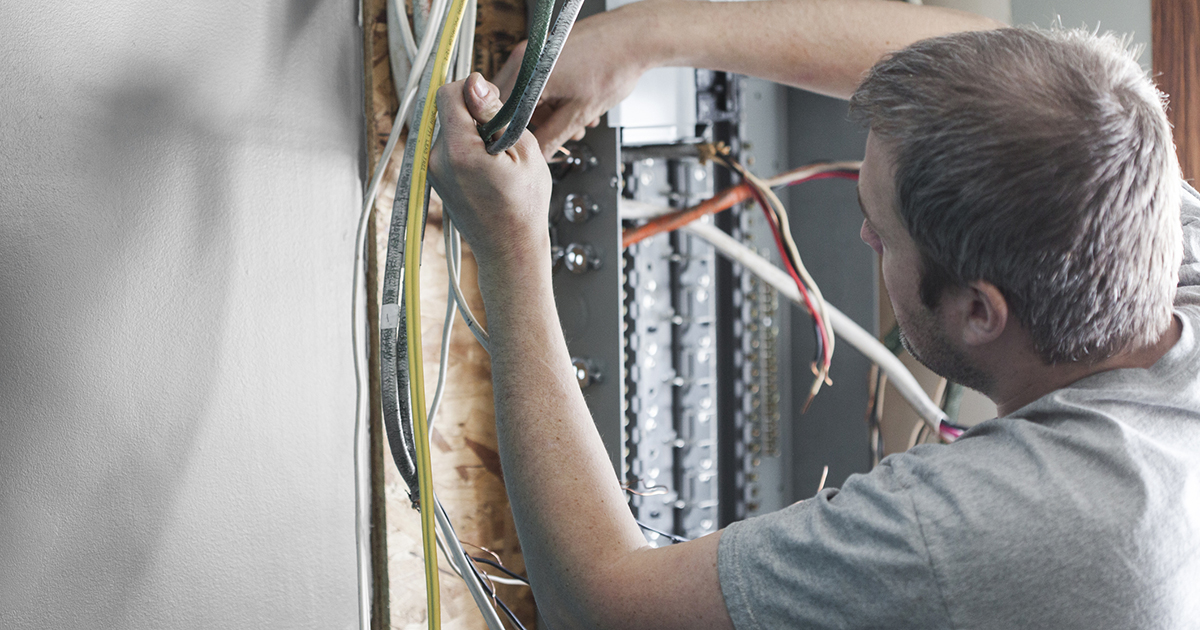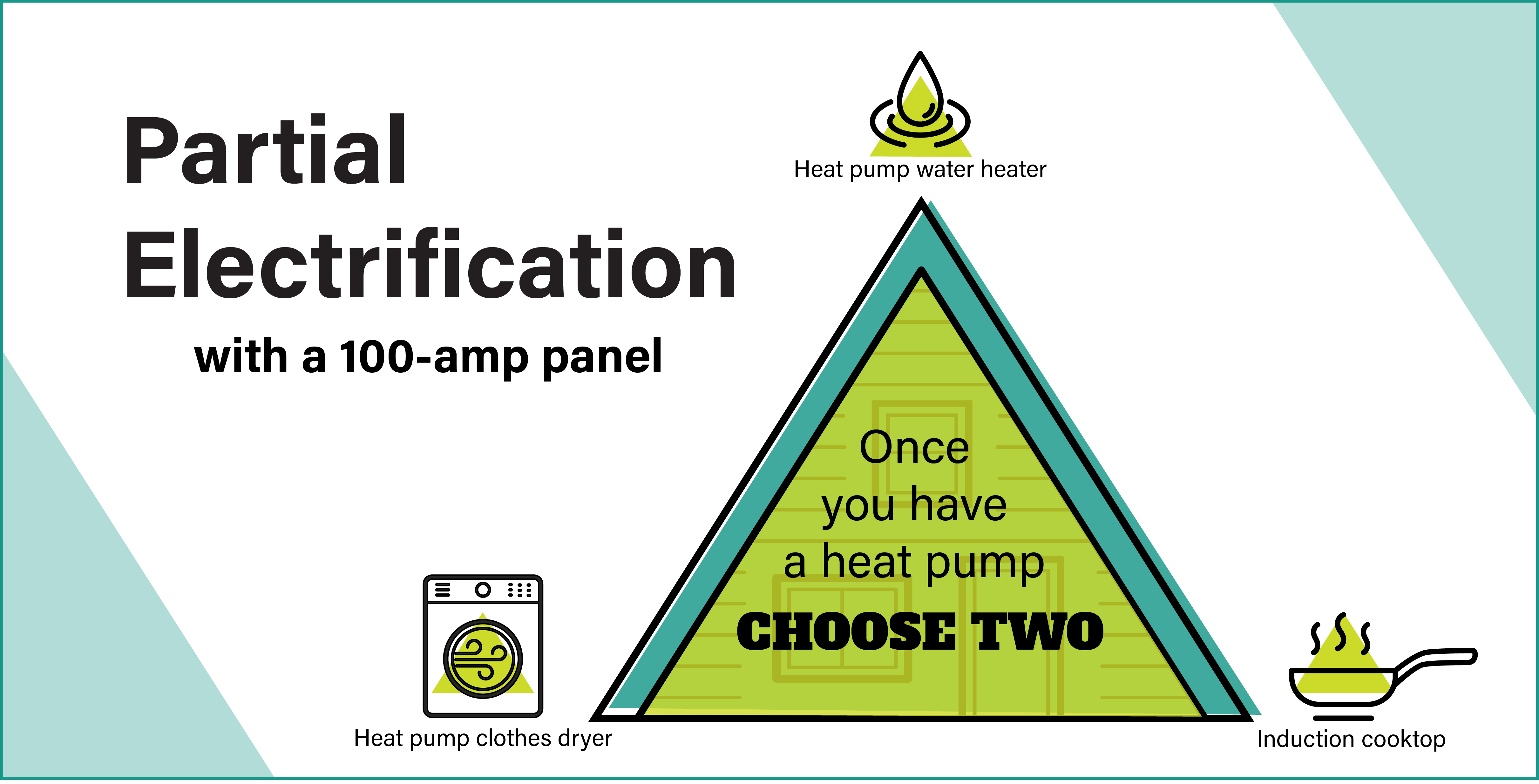
Panel upgrades are a key pathway to full electrification
Many utilities around the country are designing programs to enable residential electrification. Whatever measures we put in place, fuel switching from gas or propane to electricity adds electrical load to homes. As outlets such as Canary Media have pointed out, utilities will need to make sure customers' electrical panels and service connections can endure the extra load without encountering unexpected upgrade costs and delays to electrification.
Almost all electrification projects will require some level of electrical infrastructure work to enable the use of all these new electric appliances. There are a lot of houses—millions of them—that are not prepared for full electrification without the needed infrastructure updates.
However, most houses with 100-amp service are ready for partial electrification. We should be doing that right now.
What we learned
Many homes are not ready for full electrification without infrastructure upgrades – but we can get started with partial electrification now.What surprised us
Upgrading panel service to 200A is likely the most cost-effective and simplest way to enable residential electrification in cold climates at this time.What it means
Programs should promote partial electrification measures, IRA rebates, and panel service upgrades.What's next: More research and pilots to test smart panels and similar technologies could help some homes avoid 200A upgrades.
Background
In a recent study for ComEd's Customer Innovation initiative, we characterized the current market within ComEd’s service territory to discover hurdles to electrification and identify possible solutions.
ComEd services a large population within Illinois, a Midwestern state with a cold climate and where most existing houses use gas for cooking, space heating, and water heating. It's a typical situation in the Midwest. As such, this study has informed our observations and recommendations in this piece.
A recap of electrification measures
Electrifying a home affects many of our daily household needs. Typical electrification measures include:
- Space heating: Heat pump (usually air-source heat pump)
- Water heating: Heat pump water heater (HPWH)
- Cooking: Induction cooktop
- Clothes drying: Heat pump clothes dryer
- Transportation: EV charger
A household may choose to install any combination of these appliances and may install them all at once or over time, in any order. A household may also decide to eliminate gas altogether (full electrification) or only replace some of their gas appliances (partial electrification).
In many cases, full electrification in cold climates will increase the energy load to a degree that requires upgrading the home's electrical service to 200 amps. On the other hand, partial electrification is possible under 100-amp service.
Weatherization remains one of the most important factors to home efficiency. All programs should ensure that all homes are properly insulated before tackling electrification measures. If funding is an issue, consider partnering with income-qualified weatherization programs or including measures that increase access to financing for weatherization services.
Starting with heat pumps
For the sake of illustration, let's suppose that many households will probably want to start with electrifying their heating and cooling.
For homes with existing central air conditioning, a dual-fuel heat pump can be an effective measure to get a heat pump installed and prepare for further electrification.
The key is to avoid electric resistance backup if possible. Based on our modeling, relying on electric resistance backup for heat pumps is likely to exceed 100-amp service in most scenarios.
As with all efforts to scale the adoption of air-source heat pumps, programs should equip contractors with the knowledge and training they need to specify cold-climate heat pumps and install them effectively.
Even so, some homes may require electric resistance backup or multiple additional heat pumps. In either case, the load will increase—limiting the options available under 100-amp service.
Related Reads: In a field test of integrated controls for ductless mini-split heat pump systems in Minnesota, we found that homes with properly installed heat pumps rarely had to turn to electric resistance baseboard heat.
For partial electrification, Choose Your Own 100-Amp Adventure
Once homes limited to 100 amps have added a dual-fuel heat pump, their remaining options are limited. In most cases, homes can electrify their HVAC (without electric resistance backup) then choose two of three other things:
- Cooking: Induction cooktop
- Water heating: Heat pump water heater
- Clothes drying: Heat pump clothes dryer

Note that 120-volt technologies such as 120-volt heat pump water heaters could change the calculus here. Most HPWHs require a 240-volt outlet, and the added service that comes with it, but 120-volt HPWHs can plug in to any outlet—and reduce the added electric load to the home. Slipstream is currently conducting pilot studies on this promising technology, but we still need more research in cold climates.
Panel service upgrades are key to full electrification
In our view, upgrading a home's panel service to 200 amps is likely the most cost-effective and simplest way to enable full electrification at this time. Once a household has upgraded its electrification service, they can begin switching appliances based on their needs without worrying about the added load.
Electrical service upgrades are routine projects for electricians and utilities. They are not a barrier in themselves to electrification, as long as programs consider the financial costs and the capacity of local electricians and utility workers.
The bottom line: Programs should roll out incentives for 200-amp panel upgrades.
We suggest coordinating incentives with IRA funding and financing, or even pairing service upgrades with incentives for individual appliances as well. This slate of rebate programs from Michigan co-ops is a good example of how end users seem willing to take advantage of panel upgrades to prepare for future upgrades.
Any utility or municipality considering electrification programs will probably want to determine the prevalence of 200-amp service within their territory before setting any goals.
What about smart panels?
Emerging technologies such as smart electrical panels are a potential way for a home to upgrade its equipment without upgrading its panel service. However, they're currently more costly and more complicated than a routine panel upgrade.
At some point utilities will have to upgrade their grid infrastructure to meet the higher demand from widespread electrification. Smart panels might help utilities manage the greater load in the meantime, but it's unclear whether they'll be a long-term solution.
Other technologies such as smart breakers and circuit-splitter switches could have practical uses for some households. A switch to allow a household to toggle back and forth between an EV charger and electric water heater, for example, could allow deeper electrification on an existing 100-amp service. But many would find that inconvenient, and it is not a long-term path to full electrification either.
In both cases, we need more studies to fully understand the potential of these technologies.
Recommendations:
- Start with partial electrification now
- Offer cash incentives for service and panel upgrades
- Coordinate incentives with IRA funding and financing
- Continue research of 120-volt heat pump water heaters
- Continue research and pilots of smart panels
Learn more:
Read the Executive Summary of our electrification upgrades study on the ComEd Customer Innovation website.